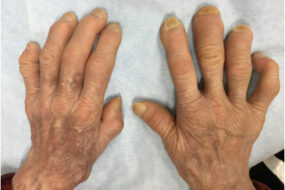- Home
- INTERNAL MEDICINE
- Renal system
- Acute Pyelonephritis
Pyelonephritis refers to infection of the renal parenchyma with local and systemic effects.
Aetiology
Ascending (gram-negative bacilli) or hematogenous route (usually gram-positive cocci)
Causative organisms:
- Gram Positives: Enterococcus faecalis, S. aureus, S. saprophyticus
- Gram Negatives: E. coli, Klebsiella, Proteus, Pseudomonas, Enterobacter spp.
Risk Factors
- Nephrolithiasis
- Prostatic obstruction
- Vesicoureteric reflux
- Neurogenic bladder
- DM, SCD, Immunosuppression, Polycystic kidney disease
- Pregnancy
- Post renal transplant
- Instrumentation
Clinical Features
- Rapid onset. Usually, less than 24hrs
- Fever, chills, N&V, malaise
- Costovertebral angle tenderness and/or flank pain
- Lower urinary tract symptoms: frequency, urgency, hematuria. Dysuria only in concomitant cystitis.
Investigations
- Urinalysis, Urine M/C/S
- FHG- Elevated WBCs
- Imaging: Renal Ultrasound, contrast-enhanced CT Scan, DMSA.
Complications
- Pyonephrosis
- Perirenal abscess
Treatment
- Hemodynamically stable – Oral outpatient antibiotics (Admit if no improvement in 24hrs)
- First choice: Cephalexin 1g QID for 14 days; Ciprofloxacin 500mg BD for 7 days.
- Second choice: Cefuroxime 750-1500mg TDS for 14 days; Gentamycin- Dose adjusted according to renal function and serum levels.
- Severe or non-resolving – Admit, hydrate, IV antibiotics
- Emphysematous pyelonephritis – Nephrectomy after IV antibiotics started and patient stabilized.
- Renal obstruction – Stenting or percutaneous nephrostomy tubes.












